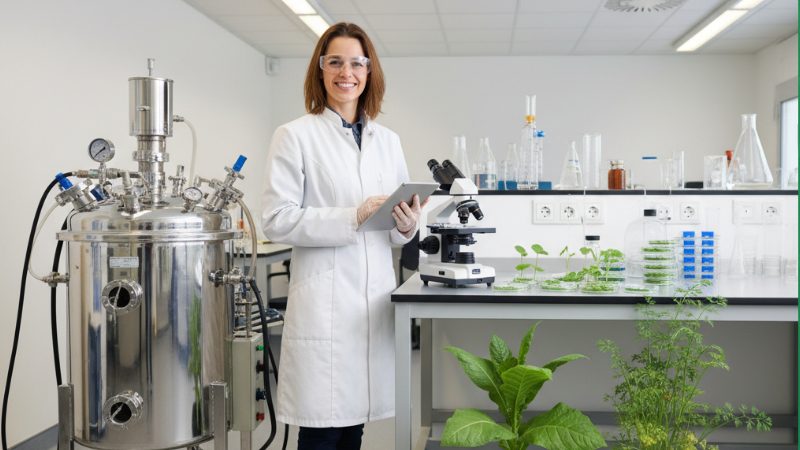In the dynamic world of biotechnology, mammalian cell cultures and microbial fermenters have long dominated as the primary tools for bioproduction. However, an unconventional contender is quietly emerging: plant-cell-based production systems. Once overshadowed by established methods, plant-cell bioreactors are now demonstrating their potential to produce pharmaceuticals and other high-value compounds efficiently and sustainably. This is the inspiring story of molecular farming—a journey of innovation, resilience, and groundbreaking progress.
By the early 1980s, pioneering work by Marc Van Montagu and Jeff Schell had elucidated the gene transfer mechanism of Agrobacterium, laying the groundwork for plant genetic engineering. They demonstrated that the T-DNA could be modified to carry foreign genes, effectively turning plants into biofactories for recombinant proteins. This breakthrough marked the inception of plant molecular farming, where plants are engineered to produce specific proteins for pharmaceutical and industrial applications.
The first significant achievement in plant molecular farming was the expression of human serum albumin in transgenic tobacco and potato plants in 1990. This accomplishment showcased the feasibility of producing complex human proteins in plants, sparking interest in the field.
Concurrently, the development of plant cell suspension cultures offered a controlled environment for producing valuable compounds. Unlike whole plants, these cultures allowed for precise control over growth conditions, leading to consistent and scalable production.
One of the most compelling advantages of plant-cell-based production systems is their intrinsic resistance to mammalian pathogens. Unlike mammalian cell cultures, plant cells are not susceptible to contamination by viruses and prions that affect humans. This inherent safety reduces the risk of pathogen transmission in biopharmaceuticals, ensuring compliance with stringent safety standards and potentially lowering the costs associated with purification and validation processes.
One of the most remarkable advantages of plant-cell-based systems lies in their ability to produce complex and specialized proteins that are challenging, if not impossible, to manufacture using conventional production systems, including toxins. Plant cells leverage their eukaryotic machinery to ensure proper protein folding and post-translational modifications, crucial for the biological activity of toxins. Unlike microbial or mammalian systems, plant cells can produce these proteins without being adversely affected by their toxic nature, thanks to their unique cellular pathways and compartmentalization. This makes plant-cell-based systems an ideal platform for producing toxins for research, therapeutic applications, and industrial uses.
Mammalian and microbial cell cultures require carefully formulated growth media, often enriched with serum, amino acids, vitamins, and other expensive additives. In contrast, plant cells thrive on simpler, low-cost media composed of basic nutrients like salts, sugar, and minimal trace elements. These requirements significantly reduce the ongoing expenses associated with large-scale production.
For instance, producing monoclonal antibodies in mammalian cells often requires serum derived from fetal bovine blood, a costly and ethically sensitive input, or expensive recombinant growth factors. In molecular farming, plant cells synthesize the same proteins without the need for such premium components, slashing costs while aligning with sustainability goals.
Plant cell-based molecular farming in bioreactors is no longer just a novel concept—it’s a proven, scalable solution reshaping biotechnology. From Protalix’s FDA-approved Elelyso™, a treatment for Gaucher’s disease, produced in carrot cells, to Greenovation Biotech’s moss-derived complement factor H, a protein involved in immune regulation and VTT’s eco-friendly cellular coffee, these success stories showcase the versatility and impact of this technology. By combining cost-effectiveness, sustainability, and intrinsic safety from mammalian pathogens, plant cell cultures are driving innovation across pharmaceuticals, agriculture, and even consumer goods. As researchers like Johannes Buyel continue to push the boundaries with plant-based production in bioreactors, the future of molecular farming promises a revolution in bioproduction, where efficiency and environmental stewardship go hand in hand. The era of plant cells as biofactories has arrived—and it’s transforming industries at their very roots.
Despite its promise, molecular farming still faces some significant hurdles:
Addressing these challenges is essential to unlocking the full potential of molecular farming.
Fortunately, ongoing research and innovation, also at the Austrian Centre of Industrial Biotechnology (acib) are delivering solutions, solidifying this platform as a sustainable and versatile alternative to traditional production methods.
The ascent of plant-cell-based production systems from obscurity to prominence exemplifies the classic underdog narrative. Through innovation, perseverance, and strategic leveraging of their unique advantages—such as safety from mammalian pathogens—plant cells have carved out a significant niche in the biotechnology landscape. As research progresses and more success stories emerge, plant-cell bioreactors are poised to play an increasingly vital role in the sustainable and efficient production of biopharmaceuticals and beyond.
